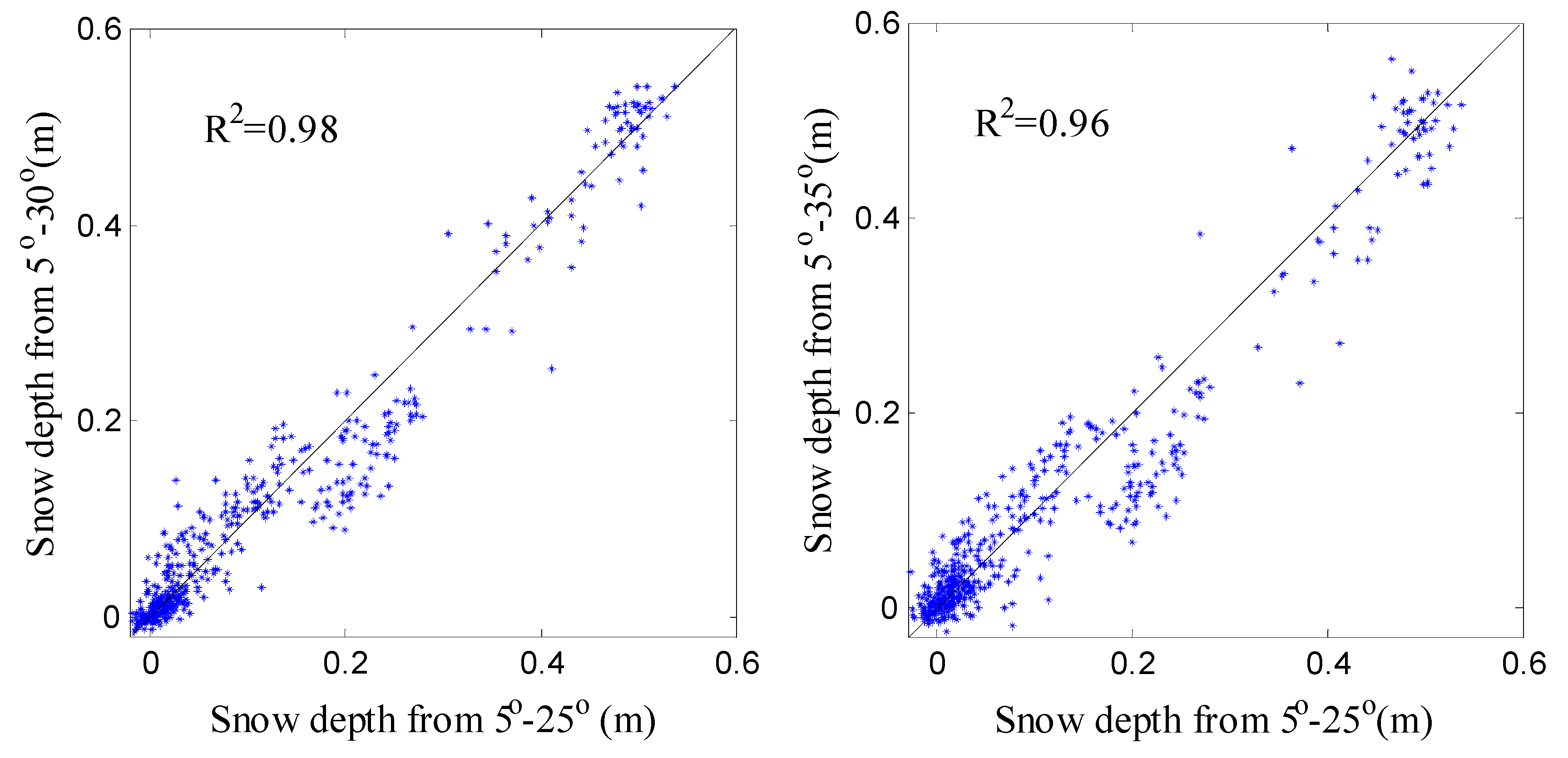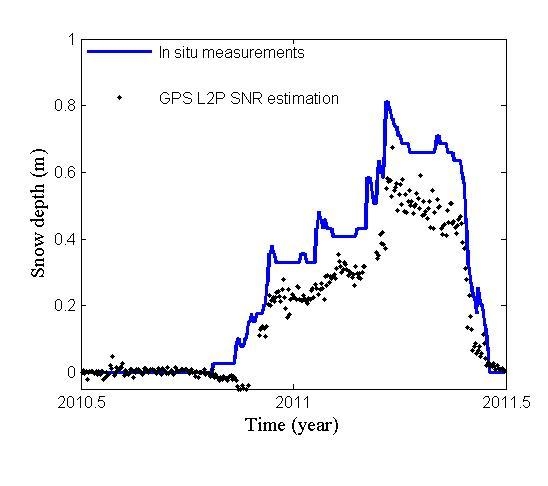Snow Depth Variations Estimated from GPS-Reflectometry: A Case Study in Alaska from L2P SNR Data
Abstract
:1. Introduction
2. GPS Observations and Climate Data
2.1. GPS Observations


2.2. Climate Data
3. Theory and Methods
3.1. Data and Methods

- (1)
- Using low-order polynomial function to fit GPS SNR time series and remove the direct trend, the multipath oscillations are obtained.
- (2)
- The domain frequency of multipath oscillations is obtained using the Lomb–Scargle periodogram.
- (3)
- The domain frequency is converted to the reflector height.
3.2. Theoretical Simulation
| GPS Signal | Wavelength (cm) | Frequency (MHz) | Chipping Rate (Mchip/s) | Code Length (Chip) | Min Received Power (dBW) |
|---|---|---|---|---|---|
| L1C/A | 19.0 | 154 × 10.23 | 1.023 | 1023 | −158.5 |
| L2P | 24.4 | 120 × 10.23 | 10.23 | 6.187 × 1012 | −164.5 |





4. Results and Validation

| Locations | Years | Correlation Coefficient | RMSE (m) |
|---|---|---|---|
| AB33 | May 2010–May 2011 | 0.98 | 0.12 |
| AB39 | May 2009–May 2011 | 0.88 | 0.12 |
| SG27 | May 2008–May 2010 | 0.79 | 0.14 |
5. Discussion and Effects
5.1. Comparison of L1 C/A and L2P



5.2. Satellite Elevation Effects


5.3. Effect of the Data Sampling Rate


6. Conclusions
Acknowledgments
Author Contributions
Conflicts of Interest
References
- Cohen, J.; Entekhabi, D. Eurasian snow cover variability and Northern Hemisphere climate predictability. Geophys. Res. Lett. 1999, 26, 345–348. [Google Scholar] [CrossRef]
- Walsh, J.E. Snow cover and atmospheric variability: Changes in the snow covering the earth’s surface affect both daily weather and long-term climate. Am. Sci. 1984, 72, 50–57. [Google Scholar]
- Rott, H.; Yueh, S.H.; Cline, D.W.; Duguay, C.; Essery, R.; Haas, C.; Heliere, F.; Kern, M.; Macelloni, G.; Malnes, E.; et al. Cold Regions Hydrology High-Resolution Observatory for Snow and Cold Land Processes. IEEE Proc. 2010, 98, 752–765. [Google Scholar] [CrossRef]
- Beniston, M. Climatic change in mountain regions: A review of possible impacts. In Climate Variability and Change in High Elevation Regions: Past, Present & Future; Springer: Dordrecht, The Netherlands, 2003; pp. 5–31. [Google Scholar]
- Gutmann, E.D.; Larson, K.M.; Williams, M.W.; Nievinski, F.G.; Zavorotny, V. Snow measurement by GPS interferometric reflectometry: An evaluation at Niwot Ridge, Colorado. Hydrol. Process. 2012, 26, 2951–2961. [Google Scholar] [CrossRef]
- Najibi, N.; Jin, S.G. Physical reflectivity and polarization characteristics for snow and ice-covered surfaces interacting with GPS signals. Remote Sens. 2013, 5, 4006–4030. [Google Scholar] [CrossRef]
- Najibi, N.; Jin, S.G.; Wu, X. Validating the variability of snow accumulating and melting from GPS reflected signals: Forward modeling. IEEE Trans. Antennas Propag. 2015, 63, 2646–2654. [Google Scholar] [CrossRef]
- Jin, S.G.; Feng, G.P.; Gleason, S. Remote sensing using GNSS signals: Current status and future directions. Adv. Space Res. 2011, 47, 1645–1653. [Google Scholar] [CrossRef]
- Jin, S.G.; Najibi, N. Sensing snow height and surface temperature variations in Greenland from GPS reflected signals. Adv. Space Res. 2014, 53, 1623–1633. [Google Scholar] [CrossRef]
- Jin, S.G.; Cardellach, E.; Xie, F. GNSS Remote Sensing: Theory, Methods and Applications; Springer: Dordrecht, The Netherlands, 2014; p. 276. [Google Scholar]
- Larson, K.M.; Braun, J.J.; Small, E.E.; Zavorotny, V.U.; Gutmann, E.D.; Bilich, A.L. GPS multipath and its relation to near-surface soil moisture content. IEEE J. Sel. Top. Appl. Earth Observ. Remote Sens. 2010, 3, 91–99. [Google Scholar] [CrossRef]
- Jin, S.G.; Occhipinti, G.; Jin, R. GNSS ionospheric seismology: Recent observation evidences and characteristics. Earth-Sci. Rev. 2015, 147, 54–64. [Google Scholar] [CrossRef]
- Zavorotny, V.U.; Voronovich, A.G. Scattering of GPS signals from the ocean with wind remote sensing application. IEEE Trans. Geosci. Remote Sens. 2000, 38, 951–964. [Google Scholar] [CrossRef]
- Zavorotny, V.U.; Larson, K.M.; Braun, J.J.; Small, E.E.; Gutmann, E.; Bilich, A. A physical model for GPS multipath caused by ground reflections: Toward bare soil moisture retrievals. IEEE-JSTARS 2010, 3, 100–110. [Google Scholar]
- Larson, K.M.; Gutmann, E.D.; Zavorotny, V.U.; Braun, J.J.; Williams, M.W.; Nievinski, F.G. Can we measure snow depth with GPS receivers? Geophys. Res. Lett. 2009, 36, L17502. [Google Scholar] [CrossRef]
- Larson, K.M.; Nievinski, F.G. GPS snow sensing: Results from the EarthScope Plate Boundary Observatory. GPS Solut. 2013, 17, 41–52. [Google Scholar] [CrossRef]
- Chen, Q.; Won, D.; Akos, D.M. Snow depth sensing using the GPS L2C signal with a dipole antenna. EURASIP J. Adv. Signal Process. 2014, 1–10. [Google Scholar] [CrossRef]
- Tabibi, S.; Nievinski, F.G.; van Dam, T.; Monico, J.F.G. Assessment of modernized GPS L5 SNR for ground-based multipath reflectometry applications. Adv. Space Res. 2015, 55, 1104–1116. [Google Scholar] [CrossRef]
- Hefty, J.; Gerhatova, L. Using GPS Multipath for Snow Depth Sensing-First Experience with Data from Permanent Stations in Slovakia. Acta Geodyn. Geomater. 2014, 11, 53–63. [Google Scholar] [CrossRef]
- Jin, S.G.; Wang, J.; Park, P.H. An improvement of GPS height estimates: Stochastic modeling. Earth Planets Space 2005, 57, 253–259. [Google Scholar]
- Nievinski, F.G.; Larson, K.M. An open source GPS multipath simulator in Matlab/Octave. GPS Solut. 2014, 18, 473–481. [Google Scholar] [CrossRef]
- Nievinski, F.G.; Larson, K.M. Inverse modeling of GPS multipath for snow depth estimation—Part I: Formulation and simulations. IEEE Trans. Geosci. Remote Sens. 2014, 52, 6555–6563. [Google Scholar] [CrossRef]
- Vey, S.; Guntner, A.; Wickert, J.; Blume, T.; Ramatschi, M. Long-term soil moisture dynamics derived from GNSS interferometric reflectometry: A case study for Sutherland, South Africa. GPS Solut. 2015, 19, 1–14. [Google Scholar] [CrossRef]
© 2016 by the authors; licensee MDPI, Basel, Switzerland. This article is an open access article distributed under the terms and conditions of the Creative Commons by Attribution (CC-BY) license (http://creativecommons.org/licenses/by/4.0/).
Share and Cite
Jin, S.; Qian, X.; Kutoglu, H. Snow Depth Variations Estimated from GPS-Reflectometry: A Case Study in Alaska from L2P SNR Data. Remote Sens. 2016, 8, 63. https://doi.org/10.3390/rs8010063
Jin S, Qian X, Kutoglu H. Snow Depth Variations Estimated from GPS-Reflectometry: A Case Study in Alaska from L2P SNR Data. Remote Sensing. 2016; 8(1):63. https://doi.org/10.3390/rs8010063
Chicago/Turabian StyleJin, Shuanggen, Xiaodong Qian, and Hakan Kutoglu. 2016. "Snow Depth Variations Estimated from GPS-Reflectometry: A Case Study in Alaska from L2P SNR Data" Remote Sensing 8, no. 1: 63. https://doi.org/10.3390/rs8010063
APA StyleJin, S., Qian, X., & Kutoglu, H. (2016). Snow Depth Variations Estimated from GPS-Reflectometry: A Case Study in Alaska from L2P SNR Data. Remote Sensing, 8(1), 63. https://doi.org/10.3390/rs8010063








